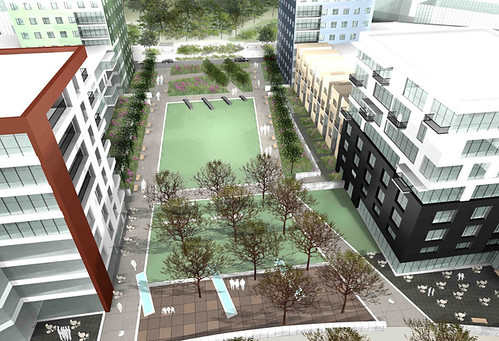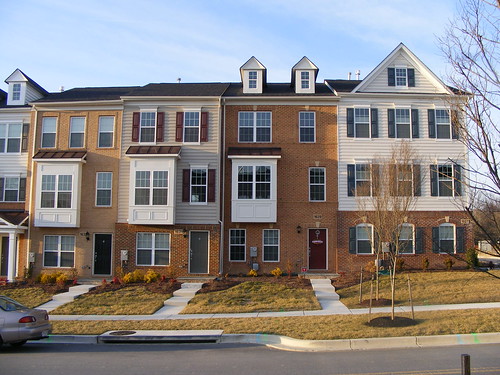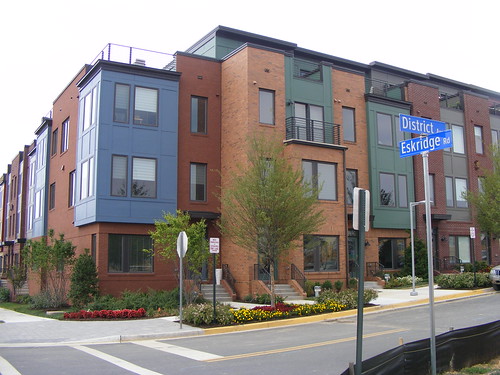A long-awaited redevelopment could finally bring new housing and retail to Glenmont. But to create a urban, walkable environment around the Metro station, the Glenmont Metrocentre project needs to be designed for pedestrians, not cars.
Today, the Montgomery County Planning Board approved a preliminary plan for Glenmont Metrocentre, a 31-acre mixed-use development at the corner of Georgia and Glenallan avenues with 1325 apartments, 225 townhomes and 90,000 square feet of retail space. It would replace Privacy World, a 1960's-era garden apartment complex with just 362 units.
County planners first envisioned this project in 1997. Ten years later, the Planning Board agreed to let developer JBG build retail in addition to housing here, but the County Council refused to approve it until Maryland approved funding for an interchange at Georgia Avenue and Randolph Road. With money in hand, the project can move forward. Next, JBG will need to submit a more detailed site plan.
The project is split into two phases. First, JBG will demolish 275 existing apartments and replace them with two apartment buildings and 4,000 square feet of retail. Meanwhile, partner Winchester Homes will build the townhouses. Later, two new buildings and more retail space would replace the remaining Privacy World apartments, but not until the interchange at Georgia and Randolph is fully funded, or the proposed Bus Rapid Transit lines along Georgia and Randolph have been built.
The developers will set aside 14.5% of the homes for low-income households, higher than the county's requirement of 12.5%. This will produce 225 affordable apartments, but it's not enough to replace all of the already-affordable units there are today.
They will also build new, wider sidewalks on Georgia Avenue and Layhill Road, and a 10-foot-wide "shared-use path" for walkers and cyclists along Glenallan Avenue. They can also pay for other improvements, like bike racks, signs that tell people when the next bus or train is coming, or a neighborhood circulator shuttle.
Plan creates great open spaces, lousy street network
JBG hired Baltimore-based architect Hord Coplan Macht, also responsible for the new Safeway and apartments in Wheaton, to design the project. On the west side of the site, closer to Georgia Avenue, are four apartment buildings with above-ground parking garages. The buildings will have between 5 and 7 floors; the tallest buildings sit along Georgia, and will also have ground-floor shops.
On the east side, closer to Layhill Road, are blocks of townhouses with rear-facing garages on alleys. Tying it all together are a network of new streets, giving residents and visitors alternatives to using existing arterial roads.
The design also creates a network of open spaces, including several pocket parks, a central lawn that serves as a community gathering spot, and a wooded area that will buffer the development from the railyard behind it.
However, the project's street network and potential architecture won't create the kind of walkable, urban environment that county planners and residents envision for Glenmont. Some blocks are really long, which encourage speeding and reduce the number of places where people can safely cross the street.
A "main street" parallel to Glenallan Avenue forms the development's spine and provides another connection between Georgia and Layhill. But according to the planning staff report, the State Highway Administration thought the intersection of the new street and Layhill was too close to Glenallan Avenue and would inconvenience drivers. Instead, the main street has been severed, forcing people to turn left, then right again before reaching Layhill Road.
Like in many new townhouse developments, the townhouses here will have rear-facing garages accessed from an alley, not the street. This can make the streets more pedestrian-friendly, but many developers use this as an opportunity to save money by getting rid of the streets entirely and arrange the townhouses so their "front" is on a pocket park instead.
The resulting layout is no less circuitous and confusing for drivers and pedestrians alike than the cul-de-sacs that alleys are meant to replace. The developers should put some more streets back into this plan, or at least redesign the townhouses in a way that forms more coherent blocks.
Pedestrian-focused design is a must
Since this is a site plan, we don't know what the buildings will actually look like. But since there will be a lot of foot traffic here, they'll need lots of detail and careful design to create an attractive, inviting pedestrian environment.
Judging from the townhouses that Winchester Homes is building up the street at Poplar Run, that may not happen here. It's as if the designers assumed that nobody would ever stand outside these houses and look at them, because very little thought went into designing the exteriors.
The windows and doors don't line up with each other, and without any trim, they look like they were pasted on. Each house has a number, but in a different place on each house, making them hard to see. And sticking utility boxes on the front of the house defeats the purpose of having an alley, which allows you to hide things like that.
Compare that to these new townhouses at the Mosaic District in Fairfax. Inside, they're very similar to the Winchester townhouses. But outside, so much more thought went into tiny details, like the way the stoop railings match the house lights, or even just making sure the windows line up with each other, creating visual interest and engages pedestrians. These are the kinds of houses that belong across the street from a Metro station.
Glenmont Metrocentre could bring new residents, shoppers and visitors to Glenmont and take advantage of a surprisingly underutilized Metro station. With so many people living and working across the street from the Metro, there will be a lot of pedestrians here. In order for this project to be successful, everything from the streets to the buildings must be designed with them in mind.
 |
| Rendering of Glenmont Metrocentre from Hord Coplan Macht. |
County planners first envisioned this project in 1997. Ten years later, the Planning Board agreed to let developer JBG build retail in addition to housing here, but the County Council refused to approve it until Maryland approved funding for an interchange at Georgia Avenue and Randolph Road. With money in hand, the project can move forward. Next, JBG will need to submit a more detailed site plan.
 |
| Privacy World today. Photo from Google Street View. |
The developers will set aside 14.5% of the homes for low-income households, higher than the county's requirement of 12.5%. This will produce 225 affordable apartments, but it's not enough to replace all of the already-affordable units there are today.
They will also build new, wider sidewalks on Georgia Avenue and Layhill Road, and a 10-foot-wide "shared-use path" for walkers and cyclists along Glenallan Avenue. They can also pay for other improvements, like bike racks, signs that tell people when the next bus or train is coming, or a neighborhood circulator shuttle.
Plan creates great open spaces, lousy street network
JBG hired Baltimore-based architect Hord Coplan Macht, also responsible for the new Safeway and apartments in Wheaton, to design the project. On the west side of the site, closer to Georgia Avenue, are four apartment buildings with above-ground parking garages. The buildings will have between 5 and 7 floors; the tallest buildings sit along Georgia, and will also have ground-floor shops.
 |
| Site plan from the Montgomery County Planning Department. |
 |
| Site plan of the lawn from Hord Coplan Macht. |
A "main street" parallel to Glenallan Avenue forms the development's spine and provides another connection between Georgia and Layhill. But according to the planning staff report, the State Highway Administration thought the intersection of the new street and Layhill was too close to Glenallan Avenue and would inconvenience drivers. Instead, the main street has been severed, forcing people to turn left, then right again before reaching Layhill Road.
Like in many new townhouse developments, the townhouses here will have rear-facing garages accessed from an alley, not the street. This can make the streets more pedestrian-friendly, but many developers use this as an opportunity to save money by getting rid of the streets entirely and arrange the townhouses so their "front" is on a pocket park instead.
The resulting layout is no less circuitous and confusing for drivers and pedestrians alike than the cul-de-sacs that alleys are meant to replace. The developers should put some more streets back into this plan, or at least redesign the townhouses in a way that forms more coherent blocks.
Pedestrian-focused design is a must
Since this is a site plan, we don't know what the buildings will actually look like. But since there will be a lot of foot traffic here, they'll need lots of detail and careful design to create an attractive, inviting pedestrian environment.
 |
| Townhouses at Poplar Run. Photo by the author. |
The windows and doors don't line up with each other, and without any trim, they look like they were pasted on. Each house has a number, but in a different place on each house, making them hard to see. And sticking utility boxes on the front of the house defeats the purpose of having an alley, which allows you to hide things like that.
 |
| Townhouses at the Mosaic District. Photo by the author. |
Glenmont Metrocentre could bring new residents, shoppers and visitors to Glenmont and take advantage of a surprisingly underutilized Metro station. With so many people living and working across the street from the Metro, there will be a lot of pedestrians here. In order for this project to be successful, everything from the streets to the buildings must be designed with them in mind.

3 comments:
I see the shape of the "greenspace" and that's not a park. What part of that square says "sit here, have fun?" Where's a water feature, or comfortable sitting area, pretty, seating friendly landscaping, comfy area for a picnic? None. You could put a fence around the square and call it a dog park, but other than that, it's current form's only use is to give guys who cut lawns employment or lip service given to the greenspace concept. It's terrible.
I see the boondoggle BRT is pressured in regardless of how people feel about it- which is continuing rejection. The BRT was a plan when conceived as a 1.8 billion dollar whole state travel system, but isolated streets service, it's useless this way and BRT is a giant waste of money. What is WRONG with the idea of not wasting money and just adding more bus lines and stops where they are needed? Empty lines cost constant money - serve the demand. Most importantly -I don't see where where these developers have added the BRT line space on their property, instead of of STEALING/ taking public road to do it. they aren't paying for us in Glenmont Wheaton's inconvenience.
Every moment we spend wasted in travel from their poor planning, I hope they'll sit at least double.
I also would like to know who thinks Glenmont un-utilized when both parking lots are full during the weekday. Using the Metro weeknights is useless because service ends so early. During the weekends, with the track-work, people often avoid the Red Line and WMATA's terrible service in general.
I would also like to remind these planners that Privacy World still currently advertises going to be having the same rental rates for the next 3 years. Obviously the residents who buy into said deal will be disappointed at being kicked out come the end of their lease to build this. Already there's a sameness to the new condo buildings put around Wheaton and Glenmont, built about the same height, the same style. They aren't particularly pretty buildings nor walkable or nice. I'm more concerned with what they plan to do to traffic. Developers always see the current roads where they come in as things they can take away from use by the other residents and companies in the area. They need to build their own up along with building parking, not take away or BRT away from the public. Is a large parking garage placed under these buildings? That will need to happen.
Although I agree architecture will be important when building so close to something like the Metro, I think some of the concerns here are over-exaggerated. For one, there was probably some level of deliberate action to not create another Glenallen drive right next to Glenallen drive. This close to Metro I would think we'd want to be discouraging through car trips. The project has enough connections to the surrounding road network to more than adequately service the new development and provide multiple options on how to come and go. I see the ultimate main focus actually being on that north/south green area between the two apartment buildings because it's a natural way for pedestrians to come and go from METRO.
Second, the developers are not always proposing fronting units on a park just to save money, it's also a deliberate design element to provide parks safe for young children that have 'eyes' on them without those eyes being streets with cars. I'd argue having units that 'front' on Layhill Rd but are accessed by an alley from within the community is just as confusing as is having a unit front on a green space with pedestrian walkways. In many ways, this is akin to how old Greenbelt was built.
Post a Comment